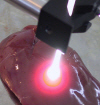by
Robert Garment, Executive Editor | April 11, 2006

New technique an
alternative to lasers
Laser light can be used to perform a number of medical procedures, such as removing cancerous tissue. The beam is fed into an optical fiber and through a catheter, heating the millimeter- or centimeter-sized growths to death. However, the technique is expensive and therefore not that widely used.

Schematic of the process



Ad Statistics
Times Displayed: 46200
Times Visited: 1302 Ampronix, a Top Master Distributor for Sony Medical, provides Sales, Service & Exchanges for Sony Surgical Displays, Printers, & More. Rely on Us for Expert Support Tailored to Your Needs. Email info@ampronix.com or Call 949-273-8000 for Premier Pricing.
In 2002, Jeffrey Gordon and colleagues at the Ben-Gurion University of the Negev in Israel developed an alternative to laser surgery that focused ordinary sunlight into a narrow optical fiber using a parabolic mirror. The device can provide the same power and flux levels as lasers but solar surgery is of limited practical value because some countries are sunnier than others.
The team has now achieved similar results using light from commercially available short-arc discharge lamps -- a system that does not rely on the presence of sunlight. The set-up uses two mirrors to concentrate the light and a third to "recycle" light emissions. This is because half the light emissions go into the hemisphere away from the concentrator. The hemispherical recycling mirror captures 50% of otherwise lost lamp emission and focuses it so that light throughput can be enhanced for an optical fiber of the same diameter.
The device has a number of advantages over lasers -- one is that its output contains visible wavelengths, which can penetrate more deeply into tissue than the infrared or ultraviolet radiation from lasers. Another bonus is cost: Gordon says that the system can destroy as much tissue per unit of energy as a laser, but is at least ten times cheaper. The device is also safer than conventional laser systems because the light can be seen, in contrast to lasers that operate outside visible wavelengths.
The team has used its new device to carry out surgery on ex-vivo chicken livers and kidneys and has also begun clinical trials on live animals. "The trials have so far yielded excellent preliminary indications and will be followed by trials on animals with cancer," says Gordon.


